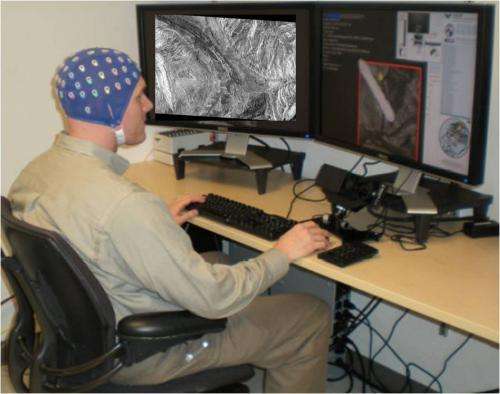September 27, 2013 report
DARPA partners with the DIY community to create the ultimate brain interface

(Phys.org) —For the last several decades huge investments have been made by the military to increase battlefield connectivity. Communicating geodata, IR-visuals, or smartweapon metrics not just to the basestation, but to other local personnel on the field, and even between devices on an individual soldier, has been high priority. Yet in just a few short years, these efforts have been completely obsoletized by smartphone technology, and the economies of scale introduced by its ubiquity. DARPA had to play a bit of catch-up recently, but they have adapted well to this new playing field. They now speak ad-hoc tactical torrents and battleclouds with the best in the business. They have also funded numerous academic efforts over the years bent on bringing neurotech to the military—only here, they are now determined not to make the same mistake twice.
This past Saturday, at the Maker Faire in New York, a new low-cost EEG recording front end was debuted at DARPA's booth. Known as OpenBCI, the device can process eight channels of high quality EEG data, and interface it to popular platforms like Arduino. Arduinos are ideal devices because there is a huge developer community that provides, among other things, "shields" which plug right in to the Arduino boards to add functionality. An Arduino is also easy to program with an intuitive language that does not require tedious assembly-level knowledge. Furthermore, additional analysis functions are provided by increasing popular Processing software development environment.
DARPA program manager William Casebeer said that his goal was to return next year to the Maker meeting with a device that costs under $30. Other low cost projects they are funding include 3D printed electrodes by a startup called S12, and wireless sensors made by Cognionics. Devices that can be readily interfaced to smartphones and tablets, like Design Interactive's headset are also a priority. There are no doubt many important motivations behind DARPA's interest in DIY. At $30 a pop, a headset on every head, or at least at every desk, may soon become a no-brainer.
The citizen scientist now has center stage. While trying to figure out what is going on inside the skull with simple EEG electrodes has its limits, the resourcefulness of those seeking to penetrate it have none. However without medical legitimacy, there are some practical considerations regarding what one might do—at least safely. The DIY brain hackers, or grinders as they are called, operate in largely uncharted territory. For example, Rich Lee, a pioneer and advocate for DIY deep brain stimulation, has implanted magnets in his fingers and ears to provide both supernumerary touch sensitivity and supplemental auditory streams. What do the powers that be think about the path where these kinds of experiments lead?
Well one recent mandate handed down from the FDA, is that implanted devices now need to have a tracking code. Inexplicably, we have up till now had an elaborate recall system in place for all manner of foods and vehicle parts, but the casual pacemaker or insulin pump could be installed without any way to track them. This new tracking code will be stored in a publicly accessible database, and will provide critical details like the make, manufacture date and lot number. How will DIY devices and implants fit into such a scheme?
We might take as an illustrative example here, the DIY auto enthusiast. These resourceful folks can build a 1925 Ford pickup in their garage entirely from mail order parts. Since they are building their own car, the parts they tend to choose are fabricated to exacting standards and material specs typically far in excess of the original quality. Some parts, like the small idler wheel that picks up a mechanical signal for the speedometer, are easy enough to fabricate for oneself, provided you get the diameter right. The license plate however, is not really a DIY item.
One legit way these hobbyists can make things simple is to use old tags. That heap of rust out in the junkyard with the tree growing up through the trunk suddenly has some value to it. Just as the definition here of the "truck" is tough to pin down, the question of what constitutes the actual medical device has much the same issues. Some progress has been made for example, in defining when a smartphone becomes a medical device, or when an app needs to be held to a higher standard, but the huge grey zone abides. For now, the EEG hobbyist is basically playing in a constrained sandlot. He or she may be able to make some impressive advances in signal processing or hardware interfacing, but until the actual signal source derives from a finer scale obtained inside the skull, their efforts will ultimately be of little practical value—at least to them.
When the DIY community begins to knock on the surgeon's door however, DARPA probably wants to be there to answer it, or at least follow them in. As stated during their request for proposals, "DARPA's mission is to prevent technological surprise for the United States and to create technological surprise for its adversaries."
More information: via TheVerge
© 2013 Phys.org




















